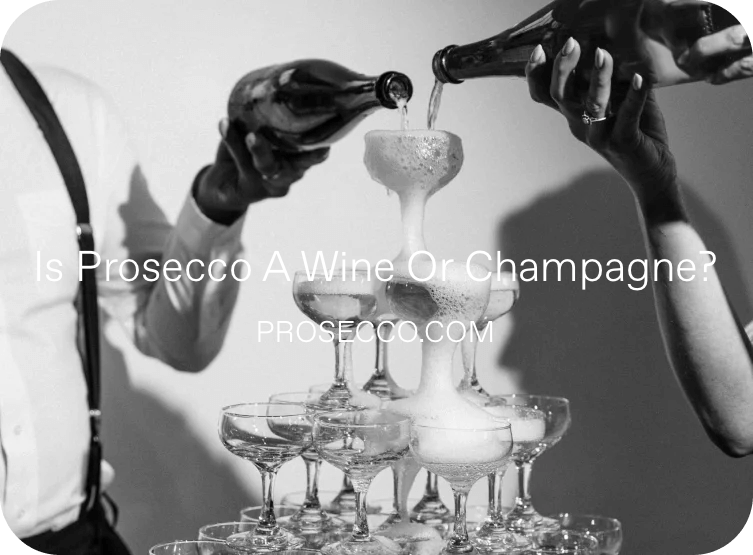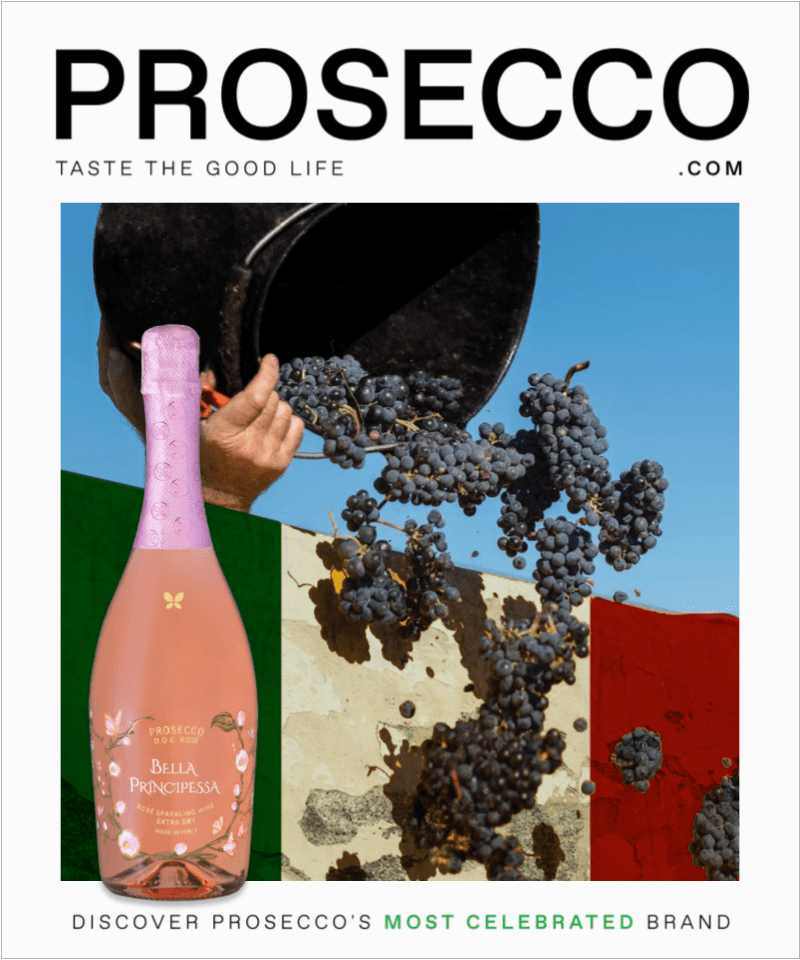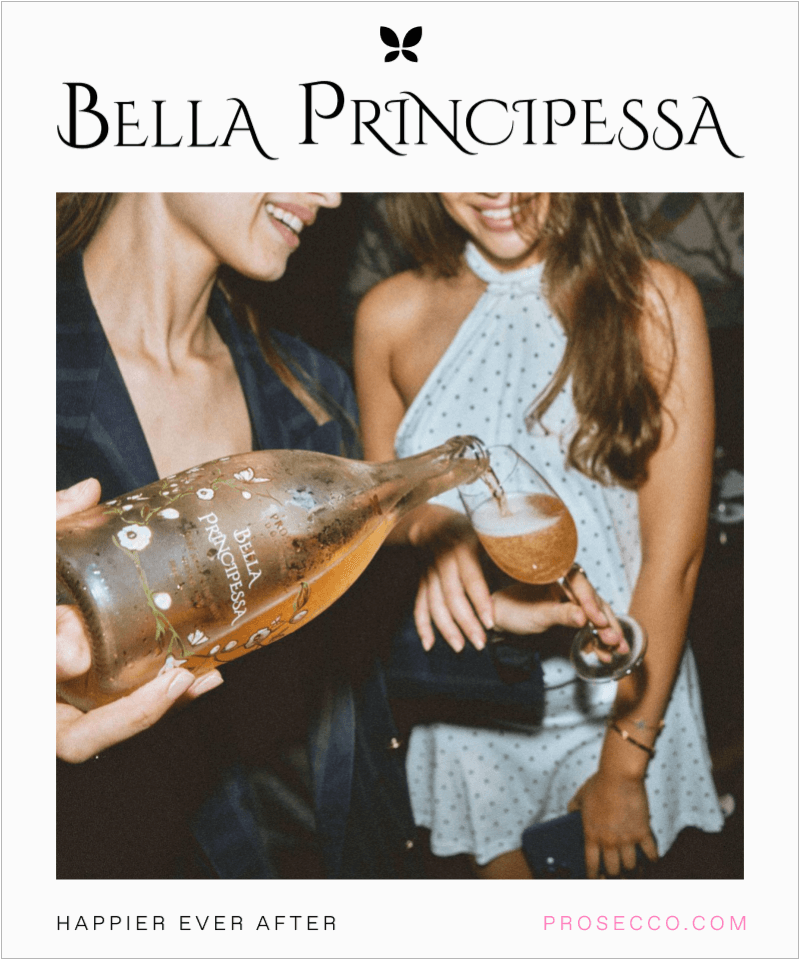Prosecco is a dry, white Italian sparkling wine made from at least 85% Glera grapes grown in the Veneto and Friuli Venezia Giulia regions. It is produced using the Charmat method, which involves a second fermentation in a pressurized steel tank to create its bubbles. While most commonly known as a sparkling wine (spumante), it can also be semi-sparkling (frizzante) or still (tranquillo).
Key characteristics
Grape: Primarily made from the Glera grape, which provides a neutral palate perfect for sparkling wine.
Production method: Made using the Charmat or tank method, where the secondary fermentation occurs in a large, pressurized steel tank. This process retains the grape’s fresh, fruity flavors like green apple and pear.
Flavor profile: It typically has a medium to high acidity and is known for its prominent fruity notes of green apple, lemon, and pear.
Types:
Spumante: Fully sparkling.
Frizzante: Semi-sparkling with gentle bubbles.
Tranquillo: Still (non-sparkling) and much less common.
Origin: Must be produced in the designated Prosecco region in northeastern Italy to be called Prosecco, protecting its geographical status.
Quality: The DOCG label indicates higher quality, while DOC is a more general classification.
Comparison: Unlike Champagne, which uses the more labor-intensive méthode champenoise and a blend of different grapes, Prosecco is often a more budget-friendly option.
From the Glera grapes used in production to pairing Prosecco with food, this guide introduces the unique details that set Prosecco apart from other wines – plus all the tips you need to get the best out of it with every sip.
With information on Prosecco brands, sweetness levels, and best serving methods, let’s explore Prosecco and discover why it’s considered one of Italy’s finest.
Short Summary
- Prosecco is a sparkling white wine from Italy made with glera grapes.
- It’s not Champagne and is produced in nine provinces across the Veneto and Friuli Venezia Giulia regions.
- It has a dry, light-bodied flavor and should be enjoyed within a year of purchase.
Is Prosecco a wine or Champagne?
Prosecco is a type of sparkling wine, while “Champagne” is a specific type of sparkling wine that can only be called that if it is made in the Champagne region of France. Both are sparkling wines, but they differ in origin, production method, and taste, making Prosecco an Italian sparkling wine and Champagne a French one.
Key differences
| Feature | Prosecco | Champagne |
|---|---|---|
| Origin | Veneto and Friuli Venezia Giulia regions in northeastern Italy | Champagne region in northeastern France |
| Grape Varieties | Primarily Glera grapes | Pinot Noir, Pinot Meunier, and Chardonnay grapes |
| Production Method | Charmat (tank) method | Traditional (bottle fermentation) method |
| Taste | Lighter, fruitier, and often sweeter with notes of pear, apple, and citrus | More complex and toasty with flavors like brioche, almond, and citrus |
| Bubbles | Lighter, frothier bubbles that don’t last as long | Finer, more delicate bubbles |
| Aging | Designed to be consumed young | Can be aged for years |
So, What is Prosecco?

Prosecco is a delicious white sparkling wine made with glera grapes from the Veneto region of Italy. It takes its name from a village in Friuli, Italy, and has been known as “prosecco” or a similar name for over 400 years.
Prosecco differs from other Italian wines as it’s exclusively a sparkling wine made from glera grapes. In contrast, other Italian wines come in red and white varieties from different grape types.
When buying Prosecco, make sure it’s from Italy, check for DOC or DOCG, look for Valdobbiadene and Conegliano, and make sure it’s made with at least 85% Glera grapes.
Higher quality Prosecco has DOCG or DOC labels, with Valdobbiadene and Conegliano versions being the most sought-after.
Some producers also make concentrated Prosecco wines, such as Asolo Prosecco DOCG and Prosecco Superiore DOCG, produced in the Valdobbiadene and Conegliano regions.
Is Prosecco Champagne?

Champagne has been around for 175 years longer than Prosecco and is made with Chardonnay, Pinot Noir, and Pinot Meunier grapes using the traditional method. This is why Prosecco isn’t Champagne—it’s all down to the law.
Prosecco’s name is protected by European law and can only come from a specific area in Italy, while Champagne is produced only in the Champagne region of France.
Prosecco comes in three quality categories: DOC, DOCG, and Superiore. DOC is the most common and usually affordable, while DOCG is a higher-quality designation produced in two specific regions.
The highest quality of the three, Superiore, is made in Conegliano Valdobbiadene Prosecco Superiore DOCG and Asolo Prosecco DOCG.
What Grapes Are Used in Prosecco?

You must have at least 85% Glera grapes for it to be legit Prosecco.
Regarding Prosecco, you can blend Glera with Chardonnay and Pinot Grigio, as well as local varieties like Verdiso, Bianchetta Trevigiana, Perera, and Glera Lunga.
Glera grapes have thin skins and decent acidity, and usually yield well, making the wine’s flavor more mellow.
The alcohol content is usually between 8.5% and 12.5% for dry wines with aromas of melon, peach, pear, honey, and white flowers. All in all, pretty light and refreshing. Non-Glera grapes can’t make up more than 15% of the blend.
When it comes to Prosecco, Glera is king. This grape variety provides the backbone of the classic Italian sparkling wine.
Glera’s light, refreshing flavor makes it perfect for sparkling wines, and its versatility makes it easy to pair with a wide range of foods and flavors.
Plus, because it’s native to Italy, Prosecco producers can craft some of the world’s best sparkling wines. So if you’re looking for a light, refreshing sparkling wine, look for Prosecco made with a Glera blend.
Where is Prosecco Produced?
Prosecco hails from northeastern Italy. It is produced explicitly in nine provinces across the Veneto and Friuli Venezia Giulia regions.
The Prosecco DOC zone is a protected area encompassing 35,000 acres, including the famous cities of Venice, Padova, Verona, Treviso, and Trieste, as well as their surrounding plains and countryside.
The Prosecco DOC zone is an important factor in the production of Prosecco, as it ensures the production process meets specific standards to be labeled as Prosecco.
This is also why higher-quality Prosecco wines are typically produced in this zone, as they must meet more stringent standards than those made elsewhere.
The grapes harvested in the Prosecco DOC zone are of higher quality and are essential to the distinctive taste of Prosecco.
Why is Prosecco Superiore DOCG considered better than DOC?
Prosecco DOCG is considered superior to Prosecco DOC because it is produced from grapes grown exclusively in the steepest and most challenging hills of Italy’s Valdobbiadene and Conegliano regions. These areas have unique soil and microclimates that allow the Glera grapes to develop complex and intense flavors.
In contrast, Prosecco DOC grapes are grown in a larger area, with less restrictive regulations and quality control. As a result, Prosecco DOC wines are typically less complex and nuanced than Prosecco DOCG wines.
Furthermore, Prosecco DOCG wines are made using traditional methods and must pass rigorous tests before being certified, ensuring consistent quality and excellence in every bottle. This is why Prosecco Superiore DOCG is often regarded as the top-tier Prosecco and is a preferred choice for those seeking a truly exceptional sparkling wine experience.
How Is Prosecco Made?
The Charmat method is the most common method for producing Prosecco.
This method was invented in the early 20th century and still uses large stainless-steel pressure tanks to carbonate the wine. The Charmat method produces sparkling wine more consistently in larger batches than ever before.
The ancestral method of making Prosecco, also known as col fondo, is a popular trend among low-intervention or “natural” producers.
This method involves bottling still-fermenting wine, which gets all fizzy in the bottle. This method adds a unique texture and a yeasty flavor due to the sediment in the bottle.
Plus, since no extra dosage is added, these wines are drier than Charmat-method Prosecco.
How to Serve Prosecco
Chill it between 6 and 10 degrees for the perfect Prosecco experience!
For Prosecco, you’ll want a tulip-shaped glass. Skip the flute and opt for a larger wine glass instead. This is the ideal way to experience the aromas and flavors of Prosecco.
Once your glass is filled with chilled Prosecco, enjoy it as an apéritif or in some tasty cocktails like spritz, mimosa, and bellini. Don’t even think about aging it.
Prosecco tastes best when you drink it immediately, not when you let it sit around for a while. Prosecco’s flavors are concentrated, so it’s best to enjoy it fresh and full of life.
How to Pair Prosecco Sparkling Wines

Prosecco is a versatile Italian sparkling wine that pairs well with a wide range of foods. From salty snacks to sweet desserts, Prosecco pairs perfectly with any meal.
There are three types of Prosecco: brut, extra dry, and dry. Brut Prosecco is the driest style and pairs well with salty snacks like chips and popcorn. Extra dry Prosecco is sweeter and ideal for spicier dishes like Thai food. Dry Prosecco is the sweetest and pairs perfectly with desserts like fruit tarts and cakes.
Some tasty food pairings for each type of Prosecco include Camembert and Brie for brut Prosecco, Parmigiano Reggiano and Gouda for extra dry Prosecco, and fruit tarts and cakes for dry Prosecco.
What About Prosecco in a Can and From a Tap?
It’s not the real deal with Prosecco in a can—it’s probably just some low-quality sparkling wine. Prosecco must be bottled according to certain regulations, and the canned variety doesn’t cut it.
The same goes for Prosecco from a tap—it’s all about the bottle rule. But don’t let that stop you from having a good time—Prosecco from a can is still enjoyable and makes for a great Instagram post.
So, if you’re looking for a way to enjoy the refreshing taste of Prosecco on the go, try Bella Vino! While we can’t label our Bella Vino sparkling wine in a can as “Prosecco” due to legal restrictions on using the name for packaging that isn’t a glass bottle, rest assured that our wine is made with the same high-quality Glera grapes from Veneto’s Prosecco region.
Savor the authentic Italian flavor of Bella Vino’s small-batch, bottle-quality wine crafted with care to deliver a delicious and bubbly experience.
Our convenient cans offer a perfect alternative to Prosecco in a glass bottle, without compromising taste or quality. We take pride in offering a sparkling wine that isn’t “dumbed down” for the can.
What Does Prosecco Taste Like?
It’s got a dry, light-bodied flavor with no tannins and a zingy acidity between 11.5% and 13.5% ABV. Perfect for a refreshing sip!
Regarding Prosecco, you can expect hints of green apple, honeydew, pear, lager, and cream. It’s usually not as bubbly as Champagne, but it can still have different levels of perlage.
Most Prosecco wines are dry brut style, but you can also find some with different sweetness levels. Whether you’re looking for a dry and crisp Prosecco or a bit sweeter, you have options to suit your taste.
How Long Does Prosecco Wine Last?
This Prosecco should be enjoyed within a year of purchase, and if you’ve already opened it, finish it within a couple of days.
To keep Prosecco in tip-top shape, store it in a cool, dry place at 10-12°C (50-54 °F).
Don’t leave it in the fridge for more than a few days, though—it’s best to enjoy it within a year.
However, once the cork is popped, you should guzzle that Prosecco within 3 days, as its flavor will decline after that. The oxidation that occurs when the bottle is opened starts the process by which Prosecco loses some of its sparkling bubbles and becomes flat.
So, if you want to enjoy the full flavor of Prosecco, it’s best to drink it quickly after opening.
What Are the Best Prosecco Brands?
If you’re looking for the best Prosecco brands, look no further than Bella Principessa and Signorina by Prosecco.com.
Bella Principessa Prosecco is a highly acclaimed brand known for its refreshing and delicate taste, with notes of apple and pear. It is produced from 100% Glera grapes from Italy’s prestigious Prosecco DOCG Asolo area.
On the other hand, Signorina Prosecco is a premium brand that offers a crisp, aromatic profile with hints of peach and apricot. It is also produced using the finest Glera grapes, handpicked from the Prosecco DOC area.
Bella Principessa and Signorina are highly regarded for their exceptional quality, unique taste, and elegant packaging, making them ideal for any special occasion.
These Prosecco wines are all crafted from high-quality grapes and produced using the traditional method.
However, the most prized Prosecco brand is Cartizze, made in the DOCG production area of the Valdobbiadene region and known for its superior grape-growing conditions. Cartizze is known for its intense aromas, floral notes, and crisp acidity, making it a highly sought-after Prosecco.
Summary: So what is Prosecco?
In conclusion, Prosecco is a delightful sparkling white wine made with the Glera grape from Italy’s Veneto region.
This light and refreshing flavor pairs well with a variety of dishes, making it ideal for any occasion. Even though Prosecco isn’t Champagne—it has its regulations that specify where it can be produced—it still offers some delightfully sweet flavors.
With three key types of Prosecco to choose from (Brut, Extra Dry, and Dry), you should have no problem finding the right bottle for your next gathering. And if prosecco in a can or from a tap is what you’re after, don’t worry – it’s still totally enjoyable. Just remember, freshness is key in Prosecco, so enjoy your bottle within a year of buying and within a couple of days of opening.
When looking for a quality Prosecco, some top brands include Bella Principessa and Signorina, and the most treasured Cartizze variety sold almost exclusively in Italy. So grab a bottle and celebrate with friends for a memorable night!
Frequently Asked Questions
Is Prosecco the same as Champagne?
No, Prosecco and Champagne are not the same. Prosecco is a sparkling wine mostly made in the Veneto region of Italy, while Champagne is produced only in the Champagne region of France.
Champagne growers strongly believe that their Champagne is a “wine of place,” meaning that it is unique and cannot be replicated elsewhere due to the specific soil, climate, and terrain of the Champagne region in France.
Similarly, Prosecco growers have a similar belief about their product. Due to its unique environmental factors, the UNESCO World Heritage Convention recognized that the Prosecco region is the only place to produce authentic Prosecco.
Therefore, both Champagne and Prosecco are considered “terroir” wines, where the unique qualities of the region contribute to the distinctive flavor and character of the wine.
Is Prosecco a dry or sweet wine?
Prosecco is generally dry or extra-dry, but its sweet, fruity notes of green apple, pear, honeydew melon, and honeysuckle give it a naturally sweeter taste.
So, although Prosecco is technically a dry wine, it has a distinctly sweet flavor.
What is so special about Prosecco?
Prosecco’s special qualities stem from its Italian origin, production method, and characteristic fresh, fruity flavor profile. It is made in specific regions of northeastern Italy, primarily from the Glera grape. It undergoes secondary fermentation in stainless-steel tanks (the Charmat method) rather than in the bottle, as in Champagne. This process creates a crisp, aromatic sparkling wine with notes of green apple, pear, and white flowers, making it a popular and versatile choice.
Prosecco is perfect for celebrating any occasion, offering a luxurious, exquisite experience that stands out. Read our post on this topic here.
What type of alcohol is Prosecco?
Prosecco is a sparkling white wine from Italy with an alcohol content of around 11% ABV. It has a fruity flavor and is generally associated with celebrations.
Prosecco is a type of sparkling wine, while “Champagne” is a specific type of sparkling wine that can only be called that if it is made in the Champagne region of France. Both are sparkling wines, but they differ in origin, production method, and taste, making Prosecco an Italian sparkling wine and Champagne a French one.











